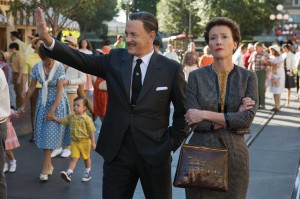
While much of the film exists within the walls of Walt’s Burbank studio lot, acute focus is given to the life and journey of Ms. Travers, a character with history in England, Australia and eventually, Hollywood. Production designer Michael Corenblith and costume designer Daniel Orlandi joined the audience post screening for a Q&A to discuss the multi-location and time-meandering film.
To accommodate Colin Farrell, who played Travers Goff, all scenes set in Australia were shot first. “It was like doing two mini-features,” said Corenblith. “We did a 17-day Australia movie, wrapped on a Friday and had the weekend to turn around the art department and have the airport ready,” referring to Ms. Travers’ arrival in Los Angeles. Since the story that took place in Australia was in 1906, shooting on the actual locations without any evidence of modern day in the frame was challenge enough to bring Australia to Big Sky Movie Ranch in Simi Valley. “The house that you see on the screen, the house where Helen Goff and Travers Goff lived, is preserved as a museum and is as it was in 1906,” said Corenblith. “We were able to dispatch Australian researchers to go and photograph every inch of the house. So, a lot of what we were able to do was very high fidelity archival recreation.”
“We thought of it as her memory of her childhood. So, Colin Farrell is probably a little more handsome than her father actually was,” Orlandi quipped. He referred to the beautiful look of Travers’ surroundings and family members contrasted against their sinking into poverty, and explained his approach to accurately depicting 1906 Allora, Australia, while maintaining the perspective of Travers as an adult looking back. “We tried to show the family, the mother holding on, you see her doing the laundry and trying to keep the clothes clean, to keep up appearances as their life was disintegrating,” explained Orlandi. “1906 Allora was a little different than 1906 New York or London. They were a little behind the times.” Orlandi researched in part by referencing newspapers from Allora in 1906 containing records of county fairs offering both he and Corenblith imagery with which to build Travers’ memories. The newspaper research even uncovered records of an actual speech given by Travers Goff at one such fair.
As production shifted to the 1961 timeline, Corenblith was tasked with turning Ontario Airport into period-accurate LAX, not to mention restoring the “happiest place on earth” to its earliest look. “There are a number of user-posted websites where people post their vacation pictures from Disneyland,” informed Corenblith. “You can really track the progress of Disneyland from 1955 to present day. This was another one of these things we weren’t expecting to have – such phenomenal archival images.” Corenblith and team mined the family photos for details that could transport the park to 1961 while adhering to strict rules regarding changes Disney would allow to its modern look. “When we started making (period accurate) Mickey, so many people had to approve you every step of the way. We probably spent more time fitting Mickey than we did Emma,” said Orlandi.
Careful attention had to be given to designing costumes for both Travers and Disney because of their iconic status today. In the film, Travers lived behind her large alligator handbag and stayed tightly wound in tweed, also wearing a gold bracelet accurate to one Travers actually wore when visiting Los Angeles in 1961. Walt was suited to project the man known to have worn grey every day. A couple of smaller details put finishing touches on Walt including the Smoke Tree Ranch insignia embroidered on his tie. “It just makes the actor feel a little bit more like the part,” said Orlandi. “His tie clip is a little train engine. Walt Disney was a huge enthusiast of trains.” This kind of detail-marksmanship is what motivated talent and transported the audience to pre-production on Mary Poppins in 1961.





